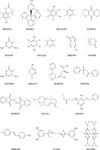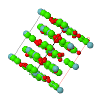issue contents
October 2004 issue

Cover illustration: Crystal packing diagram of 1,4-benzoquinone with Hirshfeld surfaces. The translucent gray surfaces illustrate the nature of these novel surfaces and how they envelop each molecule and reflect the presence of neighbouring molecules. Colours mapped on the central surface represent the distance from the surface to the nearest nucleus in an adjacent molecule: red (shortest), through green, to blue (longest) (McKinnon, Spackman & Mitchell, Acta Cryst. B, in preparation).
research papers
Download citation


Download citation


Superstructure reflections have been observed in the room-temperature X-ray diffraction pattern of BaCuSi2O6. At 610 K the compound undergoes a structural phase transition upon which these superstructure reflections disappear.
Crystal structure determination by Rietveld analysis of powder X-ray diffraction data shows that members of the geikielite–ecandrewsite solid-solution series Mg1−xZnxTiO3 (0 ≤ x ≤ 0.8) adopt the R ilmenite structure. Data are presented for cell dimensions, atomic coordinates and bond lengths together with volumes and distortion indices for all coordination polyhedra.
ilmenite structure. Data are presented for cell dimensions, atomic coordinates and bond lengths together with volumes and distortion indices for all coordination polyhedra.
Download citation


Download citation


The crystal structures of salts of phthalic acid with MgO, diethylamine and 2,2′-dipyridylamine have been determined. An analysis is made of the two different hydrogen-bond patterns observed in the crystal structures of the hydrogen phthalate salts found in the Cambridge Structural Database.
Download citation


Download citation


Open  access
access
 access
accessCrystals of the dihydrates of three halopyridinium hexachloroplatinate salts form networks that are propagated via N—H⋯O and O—H⋯Cl—Pt hydrogen bonds and Pt—Cl⋯X—C halogen bonds. The water molecules can be considered to have been inserted into N—H⋯Cl—Pt hydrogen bonds anticipated in the anyhdrous form of such salts.
Download citation


Download citation


Strategies for the structure determination of endohedral fullerenes were applied to the example of Ba@C74·Co(OEP)·2C6H6.
Download citation


Download citation


Using synchrotron powder-diffraction data and direct-space search techniques, crystal structures have been obtained at room temperature and 90 K for the compounds [Fe(teeX)6](BF4)2 (teeX is haloethyltetrazole, and X = I and Br), which both show a gradual, complete high-spin-to-low-spin transition according to molar magnetic susceptibility and 57Fe Mössbauer spectroscopy.
The position of the molecular centre in the unit cell in relation to the symmetry operators of a space group has been found to correlate with the packing pattern used to describe the crystal structure.
An analysis of polymorphs retrieved from the Cambridge Structural Database shows that common one-, two- or three-dimensional molecular arrangements in the different forms can be identified for approximately half of the polymorphic systems investigated.
Download citation


Download citation


The electron density of the complex of 4,4′-dipyridyl-N,N′-dioxide with 1,4-diiodotetrafluorobenzene has been determined by X-ray diffraction at 90 K and by accurate theoretical calculations. The topological properties of the I⋯O halogen bond are reported and compared with those of the I⋯N halogen bond obtained in a previous study.
Download citation


Download citation


Crystal structure determinations are presented for L-isoleucyl-L-isoleucine in four different protonation states: as a zwitterion, a cation, an anion and a dimeric cation.
Download citation


Download citation


Variable-temperature X-ray crystal structure analyses of N-benzylideneanilines revealed that the torsional vibration of the C—Ph and N—Ph bonds causes an apparent shortening of the C=N bond at room temperature.
Download citation


Download citation


Variable-temperature X-ray crystal structure analyses of several N-benzylideneanilines revealed that a conformational change through a pedal motion takes place in the crystals.
Download citation


Download citation


The bis(nosylate) derivative of catechol, 2-{[(4-nitrophenoxy)sulfonyl]oxy}phenyl 4-nitrophenyl sulfate, exhibits an unusual extended solid-state structure (a one-dimensional hydrogen-bonded polymer) that is based on the formation of complementary intermolecular (aryl)C—H⋯O(nitro) hydrogen-bond pairs. The molecular and `supramolecular' structure of this system has been further delineated using quantum chemical calculations (AM1 method) and molecular mechanics (MM+) simulations.
Download citation


Download citation


The crystal structures of six nitrotoluene derivatives, synthesized by Wilhelm Koerner about a century ago and retrieved from a depository at the University of Milano, were determined. The crystal packings have been analyzed and lattice energies have been calculated by atom–atom potential methods and by the newly proposed Pixel method.
Download citation


Download citation


The disordered crystal structure of 3,5-di-tert-butylpyrazole in its high-temperature phase has been described in terms of the superposition of two tautomeric forms. A phase transition at ∼ 110 K leads to the reorganization of the lattice to an ordered array of different conformers.


 journal menu
journal menu
































